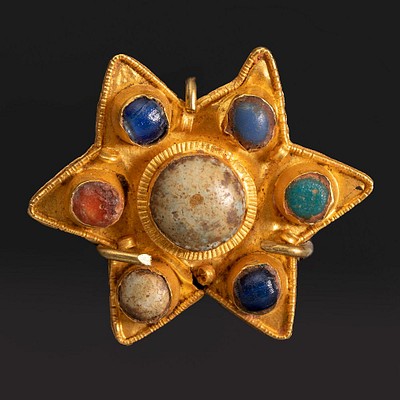Workshop of ANTONIO DEL CASTILLO Y SAAVEDRA (Cordoba, 1616 - 1668). "Salome receiving the head of St. John the Baptist". Oil on canvas. Preserves or
Lot 81
About Seller
Setdart Auction House
Carrer Aragó 346
Barcelona
Spain
Setdart Subastas was born in 2004 and is currently the first online art auction in Spain with solidity, prestige and reliability guaranteed by our more than 60,000 users. Setdart has a young, dynamic and enterprising team ready to successfully manage the purchase and sale of art works through custom...Read more
Estimate:
EUR€4,000 - EUR€4,500
$4,301.08 - $4,838.71
Absentee vs Live bid
Two ways to bid:
- Leave a max absentee bid and the platform will bid on your behalf up to your maximum bid during the live auction.
- Bid live during the auction and your bids will be submitted real-time to the auctioneer.
Bid Increments
| Price | Bid Increment |
|---|---|
| EUR€0 | EUR€10 |
| EUR€200 | EUR€25 |
| EUR€500 | EUR€50 |
| EUR€1,000 | EUR€100 |
| EUR€3,000 | EUR€200 |
| EUR€5,000 | EUR€500 |
| EUR€10,000 | EUR€1,000 |
| EUR€20,000 | EUR€2,000 |
| EUR€50,000 | EUR€5,000 |
About Auction
By Setdart Auction House
Dec 21, 2021
Set Reminder
2021-12-21 07:30:00
2021-12-21 07:30:00
America/New_York
Bidsquare
Bidsquare : Córdoba: 2,000 Years of Art
https://www.bidsquare.com/auctions/setdart-auction-house/c-rdoba-2-000-years-of-art-8049
Setdart Auction House sofia@setdart.com
Setdart Auction House sofia@setdart.com
- Lot Description
Workshop of ANTONIO DEL CASTILLO Y SAAVEDRA (Cordoba, 1616 - 1668). "Salome receiving the head of St. John the Baptist". Oil on canvas. Preserves original canvas. Presents inscription on the back. Measurements: 66 x 50 cm; 75 x 59 cm (frame). Herodias, wife of Herodes Filipo, married in a scandalous way with the stepbrother of this one, Herodes Antipas, which provoked a war, since Herodes Antipas had repudiated for it to his previous wife, daughter of the Nabatean monarch. The attitude of the new marriage was very criticized by the people, since it was considered sinful, and one of those who most denounced it was John the Baptist, for which he was arrested, although Herod did not dare to execute him for fear of the popular wrath. According to tradition, Salome, a woman of great beauty, danced for her stepfather, and he enthusiastically offered to grant her the prize she desired. Then the young woman asked, following her mother's instructions, for the Baptist's head, which was given to her "on a silver platter" This work stands out for its narrative unity, since we can appreciate the precise moment in which Salome receives the head of the saint, who has just been beheaded. The dramatism with which the body of the saint is presented to the spectator stands out, increased by the way in which Salome steps on the already dead body of St. John. Due to the technical characteristics of the work, this painting can be inscribed in the artistic circle of Antonio del Castillo. Considered the father of the Cordovan school, known for his work as a painter, he was also a polychromator and designer of architectural, decorative and goldsmith projects. He was the son of Agustín del Castillo, a little known painter from Llerena (Extremadura) whom Palomino describes as "an excellent painter". It is also believed that he may have trained as a polychromator in Calderón's workshop. However, he was orphaned when he was only ten years old, in 1626, and went on to develop his training in the workshop of another painter of whom we have no news, Ignacio Aedo Calderón. Although there is no real evidence of this, it is believed that he may have arrived in Seville, where, according to Palomino, he entered Zurbarán's workshop. This has been corroborated by the stylistic influence of the master from Extremadura that historians have seen in Castillo's work. However, in 1635 he was back in his native Cordoba, where he married and settled permanently, to finally become without discussion the most important artist of the city. His fame and quality earned him important commissions, including religious altarpieces, portraits and medium-sized series. He was also the teacher of outstanding Cordovan painters of the following generation, such as Juan de Alfaro y Gámez. Regarding his language, Antonio del Castillo did not develop an evident evolution in his work, although towards the end of his life a more softened language can be appreciated, and he kept away from the baroque novelties of other contemporary painters. However, like the rest of his contemporaries, he was seduced by the novelty of Murillo's work, and in his last years he would introduce the Venetian chromatic softness of the Sevillian master. Today, examples are kept in the Prado Museum, the Hermitage in St. Petersburg, the J. Paul Getty in Los Angeles, the Louvre, the Metropolitan in New York, etc.
- Shipping Info
-
In-house shipping available. Please inquire at admin@setdart.com.
-
- Buyer's Premium



 EUR
EUR CAD
CAD AUD
AUD GBP
GBP MXN
MXN HKD
HKD CNY
CNY MYR
MYR SEK
SEK SGD
SGD CHF
CHF THB
THB

















